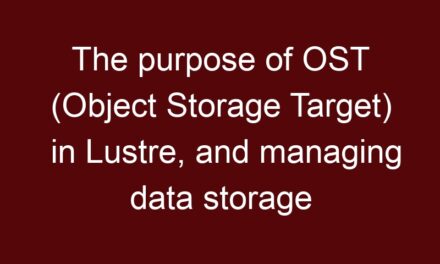Inodes are data structures used in file systems to store metadata about files and directories. An inode (index node) contains information such as the file type, ownership, permissions, timestamps, and pointers to the data blocks that make up the file’s content. Inodes act as a central database that tracks information about individual files within the file system.
In the Lustre architecture, inodes play a crucial role in managing the file system’s metadata. However, it’s essential to understand that Lustre has a unique approach to handling inodes compared to traditional file systems like ext4 or NTFS.
In Lustre, the management of inodes is distributed and parallelized to achieve scalability and high performance. Here’s how inodes are handled in the Lustre architecture:
- Metadata Servers (MDSs): Lustre employs one or more MDSs, which are responsible for managing file system metadata, including inodes. Each MDS handles a portion of the file system’s metadata, and metadata is distributed across multiple MDSs. This distribution ensures that the management of inodes is parallelized and can scale to accommodate large file systems and high metadata workloads.
- Distributed Lock Manager (DLM): In a Lustre file system, the DLM plays a critical role in coordinating access to shared files and metadata, including inodes. When a client node initiates a metadata operation that involves inodes (e.g., file creation, modification), it must acquire appropriate locks from the DLM to prevent conflicts with other concurrent operations from different clients. The DLM ensures that inodes are accessed and modified in a coordinated and consistent manner across distributed MDSs.
- Metadata Distribution: The Lustre file system dynamically distributes inodes across multiple MDSs to achieve better load balancing and scalability. Directory hierarchies are divided among MDSs, and directories can be moved between MDSs dynamically based on workload and load balancing requirements. This dynamic distribution optimizes the handling of inode-related metadata operations.
- Metadata Caching: To reduce the frequency of inode-related metadata operations that need to be sent to the MDS, Lustre clients employ metadata caching. When a client accesses a file or directory, the inode information is cached locally on the client node, reducing the need to access the MDS for every operation involving that inode.
Overall, Lustre’s distributed and parallel approach to managing inodes allows for efficient scaling and performance in metadata-intensive environments. The MDSs coordinate and manage inodes, and the DLM ensures proper concurrency control, enabling Lustre to provide a high-performance and scalable distributed file system suitable for data-intensive workloads in HPC and big data applications.





